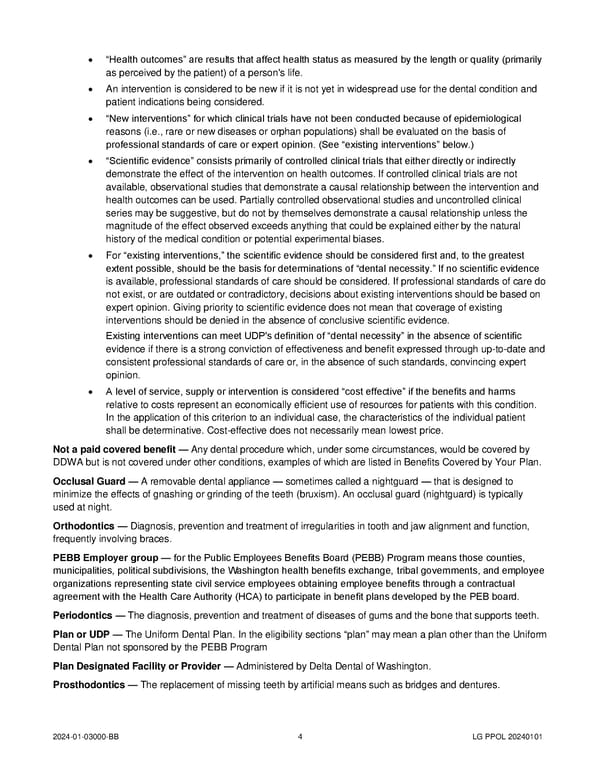• “Health outcomes” are results that affect health status as measured by the length or quality (primarily as perceived by the patient) of a person's life. • An intervention is considered to be new if it is not yet in widespread use for the dental condition and patient indications being considered. • “New interventions” for which clinical trials have not been conducted because of epidemiological reasons (i.e., rare or new diseases or orphan populations) shall be evaluated on the basis of professional standards of care or expert opinion. (See “existing interventions” below.) • “Scientific evidence” consists primarily of controlled clinical trials that either directly or indirectly demonstrate the effect of the intervention on health outcomes. If controlled clinical trials are not available, observational studies that demonstrate a causal relationship between the intervention and health outcomes can be used. Partially controlled observational studies and uncontrolled clinical series may be suggestive, but do not by themselves demonstrate a causal relationship unless the magnitude of the effect observed exceeds anything that could be explained either by the natural history of the medical condition or potential experimental biases. • For “existing interventions,” the scientific evidence should be considered first and, to the greatest extent possible, should be the basis for determinations of “dental necessity.” If no scientific evidence is available, professional standards of care should be considered. If professional standards of care do not exist, or are outdated or contradictory, decisions about existing interventions should be based on expert opinion. Giving priority to scientific evidence does not mean that coverage of existing interventions should be denied in the absence of conclusive scientific evidence. Existing interventions can meet UDP's definition of “dental necessity” in the absence of scientific evidence if there is a strong conviction of effectiveness and benefit expressed through up-to-date and consistent professional standards of care or, in the absence of such standards, convincing expert opinion. • A level of service, supply or intervention is considered “cost effective” if the benefits and harms relative to costs represent an economically efficient use of resources for patients with this condition. In the application of this criterion to an individual case, the characteristics of the individual patient shall be determinative. Cost-effective does not necessarily mean lowest price. Not a paid covered benefit — Any dental procedure which, under some circumstances, would be covered by DDWA but is not covered under other conditions, examples of which are listed in Benefits Covered by Your Plan. Occlusal Guard — A removable dental appliance — sometimes called a nightguard — that is designed to minimize the effects of gnashing or grinding of the teeth (bruxism). An occlusal guard (nightguard) is typically used at night. Orthodontics — Diagnosis, prevention and treatment of irregularities in tooth and jaw alignment and function, frequently involving braces. PEBB Employer group — for the Public Employees Benefits Board (PEBB) Program means those counties, municipalities, political subdivisions, the Washington health benefits exchange, tribal governments, and employee organizations representing state civil service employees obtaining employee benefits through a contractual agreement with the Health Care Authority (HCA) to participate in benefit plans developed by the PEB board. Periodontics — The diagnosis, prevention and treatment of diseases of gums and the bone that supports teeth. Plan or UDP — The Uniform Dental Plan. In the eligibility sections “plan” may mean a plan other than the Uniform Dental Plan not sponsored by the PEBB Program Plan Designated Facility or Provider — Administered by Delta Dental of Washington. Prosthodontics — The replacement of missing teeth by artificial means such as bridges and dentures. 2024-01-03000-BB 4 LG PPOL 20240101
 Uniform Dental Plan COC (2024) Page 8 Page 10
Uniform Dental Plan COC (2024) Page 8 Page 10